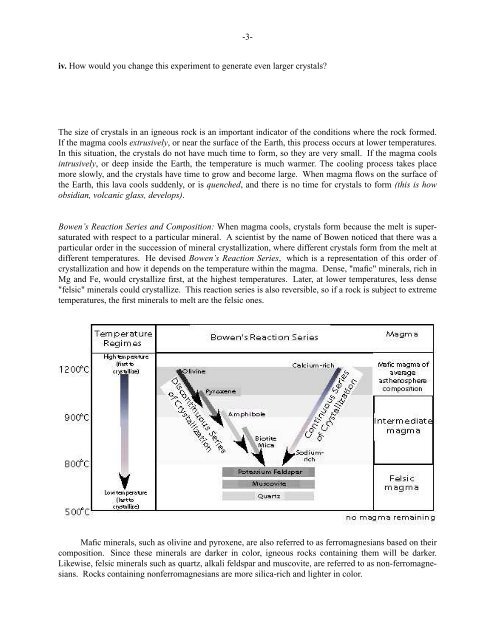Lab 4: Rock-cycle and Igneous Rocks Earth 202: Earth's Interior
Lab 4: Rock-cycle and Igneous Rocks Earth 202: Earth's Interior
Lab 4: Rock-cycle and Igneous Rocks Earth 202: Earth's Interior
You also want an ePaper? Increase the reach of your titles
YUMPU automatically turns print PDFs into web optimized ePapers that Google loves.
-3-<br />
iv. How would you change this experiment to generate even larger crystals?<br />
The size of crystals in an igneous rock is an important indicator of the conditions where the rock formed.<br />
If the magma cools extrusively, ornear the surface of the <strong>Earth</strong>, this process occurs at lower temperatures.<br />
In this situation, the crystals do not have much time to form, so they are very small. If the magma cools<br />
intrusively, ordeep inside the <strong>Earth</strong>, the temperature is much warmer. The cooling process takes place<br />
more slowly, <strong>and</strong> the crystals have time to grow <strong>and</strong> become large. When magma flows on the surface of<br />
the <strong>Earth</strong>, this lava cools suddenly, oris quenched, <strong>and</strong> there is no time for crystals to form (this is how<br />
obsidian, volcanic glass, develops).<br />
Bowen’s Reaction Series <strong>and</strong> Composition: When magma cools, crystals form because the melt is supersaturated<br />
with respect to a particular mineral. Ascientist by the name of Bowen noticed that there was a<br />
particular order in the succession of mineral crystallization, where different crystals form from the melt at<br />
different temperatures. He devised Bowen’s Reaction Series, which is a representation of this order of<br />
crystallization <strong>and</strong> how itdepends on the temperature within the magma. Dense, "mafic" minerals, rich in<br />
Mg <strong>and</strong> Fe, would crystallize first, at the highest temperatures. Later, atlower temperatures, less dense<br />
"felsic" minerals could crystallize. This reaction series is also reversible, so if a rock is subject to extreme<br />
temperatures, the first minerals to melt are the felsic ones.<br />
Mafic minerals, such as olivine <strong>and</strong> pyroxene, are also referred to as ferromagnesians based on their<br />
composition. Since these minerals are darker in color, igneous rocks containing them will be darker.<br />
Likewise, felsic minerals such as quartz, alkali feldspar <strong>and</strong> muscovite, are referred to as non-ferromagnesians.<br />
<strong>Rock</strong>s containing nonferromagnesians are more silica-rich <strong>and</strong> lighter in color.













